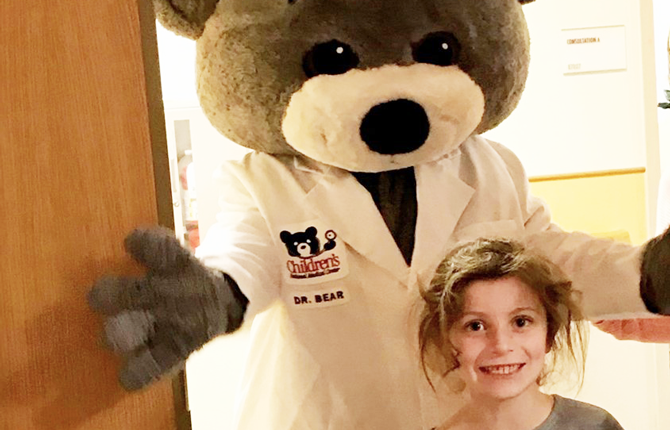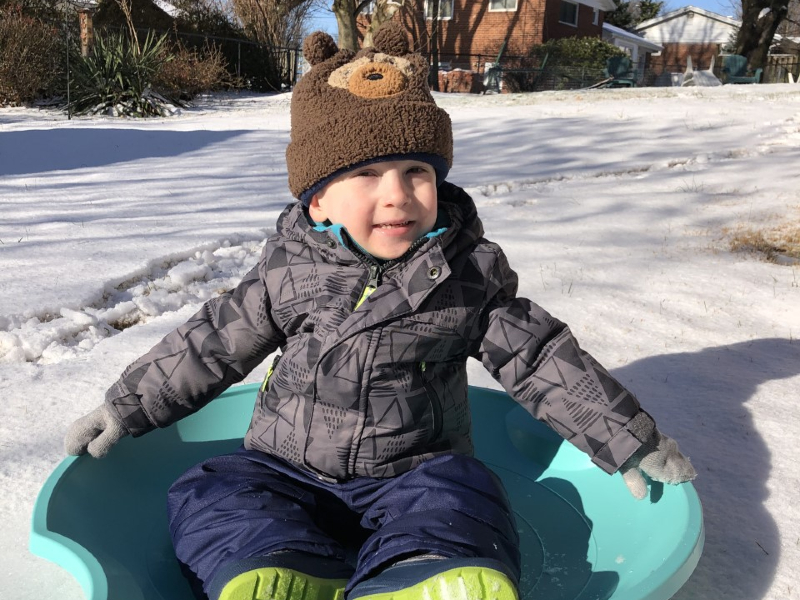Treatment
Tube Feeding
If your child loses too much weight or can't eat, they may need nutrition supplements. These supplements give water, fiber, fat, protein, vitamins, and other nutrients the body needs. If supplements can't take by mouth, special tubes can be put in your child's body. These tubes allow them to get fluid and nutrients without eating or drinking.
Frequently Asked Questions
What are the different types of tubes used?
- Nasogastric (NG) tube. This tube is long, soft, and thin. It goes into your nose and down your esophagus to your stomach. An NG tube might be used if you need nutritional support for only a short time, often less than 6 weeks.
- Gastrostomy tube (G-tube). This short tube is put in by a surgeon or gastroenterologist. It's put right into your stomach through a small hole made in the skin over your belly. The end of the tube sticks out of your skin. This is also called a PEG tube (percutaneous endoscopic gastrostomy tube). It might be needed if you'll need support for a long time,
- Jejunostomy tube (J-tube). This tube is like a G-tube. But it's put into the upper part of your small intestine (jejunum), not your stomach. It might be better to use if you have reflux or your stomach empties slowly.
All these tubes can be capped when they're not being used. The type of tube you have depends on how long you'll need to get tube feedings, your overall health, and your preferences.
How do I care for my child's feeding tube?
You'll need to learn to care for the feeding tube and to give feedings. You'll also need to learn about some of the problems that can happen with tube feedings, how to manage them, and what to report to your healthcare provider.
You will learn how to store and prepare the nutritional feedings, how to start and stop the infusions, and what to do if problems happen. You'll also be given written instructions and numbers to call in case you have problems or questions. Be sure to ask questions if you have trouble or are concerned about the feeding tube or any part of the tube feeding plan.
How do I prevent problems in my child's feeding tube?
When care is taken to give tube feedings safely and correctly, many problems can be avoided.
Here are some of the more common problems people have and what you can do to try to prevent them:
Aspiration
This is when the liquid food that was put in the stomach backs up and is breathed (inhaled) into the lungs.
To help prevent aspiration:
- Have your child sit up during each feeding and for at least 30 minutes after it's done.
- If feeding is ongoing all day (continuous), keep your child's head raised on 2 or 3 pillows while sleeping.
- Check for food that's still in their stomach (residual food) before giving a feeding. (Your nurse will teach you how to do this.)
- Check placement of the tube before starting each feeding. (Your nurse will teach you how to do this.) Don't start a feeding if your child feels full or bloated.
Diarrhea
To help prevent diarrhea:
- Don't use a feeding solution that has been open and at room temperature for more than 6 hours.
- Don't use feeding solution left open in the refrigerator longer than 24 hours.
- Wash your hands before handling the tube or the feeding solution.
- Keep the bag and tubing or syringes clean. Infection from supplies can cause diarrhea and other problems.
- Make sure you store, clean and use the tube feeding equipment carefully. Wash your hands before using the tube.
Constipation
To help prevent constipation:
- Ask about adding fiber to your feeding solution.
- Talk with your child's pediatrician about using a stool softener or laxative.
- Increase physical activity as allowed.
Skin irritation
To help prevent skin irritation:
- Keep the skin around the feeding tube clean and dry.
- Watch for leakage around the tube. If it's leaking, tell your child's pediatrician right away.
- Tape the tube securely to keep from pulling on it.
- Change the dressing every day and any time it gets wet.
- Use skin protectant as needed.
- Contact your child's pediatrician if their nostril with the tube in it or the skin around the tube looks infected (red, painful, or oozing fluid).
Loss of body fluids (dehydration)
To help prevent dehydration:
- Ask your nurse about increasing the amount of water given through the tube between feedings.
- Watch for decreased amount of urine, less frequent urination, or dark-colored urine.
- Watch for signs of thirst or fever.
Tube clogging
To help keep your tube from clogging:
- Make sure there are no kinks in the tube.
- Flush the tube after feedings.
- Flush the tube before and after putting medicine in it.
- Only use liquid medicines that are not thick syrups.
Management
The tube feedings will be given on a schedule that best fits your child's needs and the amount of calories required. Your child's pediatrician, dietitian or nurse will talk with you about the schedule that's best. The choices are:
- Intermittent or bolus. The amount of tube feeding for the day is divided up into smaller portions to be given at set times during the day over short periods. This may be done by gravity (letting the liquid run into the tube on its own) or syringe (using a syringe to gently push in the liquid into the tube).
- Continuous tube feeding. The amount of tube feeding for the day is given slowly over a 24-hour period. A pump is used to keep the rate slow and steady.
It's important to make sure the tube is in the right place before starting each feeding. You will be taught how to do this. Make sure you do it every time you use the tube.
When should I follow-up with my child's pediatrician?
If you find the feedings are not working well, check with your child's pediatrician or dietitian. Talk with them about changing the rate of feeding or the method of feeding.
Blood work will be done regularly to make sure the supplement is the right amount of nutrition, vitamins, and minerals. You may also be asked keep track of your child's weight.
If the tube becomes dislodged or falls out, put a dressing over the opening and call your child's pediatrician right away. Also call your child's pediatrician right away if the tube changes in length.
Tell your child's pediatrician right away if you notice any of the following:
- Fever that lasts more than 24 to 48 hours
- Fever of 100.4°F (38ºC) or higher, or as directed by your child's pediatrician
- Diarrhea for more than 1 day
- Nausea or vomiting
- Constipation
- Swelling or bloating in your belly
- Tube clogging
- Shortness of breath
- Coughing
- Abnormal sleepiness, disorientation, or confusion
Be sure you know what other problems you should watch for. Also be sure you know how to get help any time. Know what number to call after office hours, on weekends, and on holidays.
What are the different types of tubes used?
- Nasogastric (NG) tube. This tube is long, soft, and thin. It goes into your nose and down your esophagus to your stomach. An NG tube might be used if you need nutritional support for only a short time, often less than 6 weeks.
- Gastrostomy tube (G-tube). This short tube is put in by a surgeon or gastroenterologist. It's put right into your stomach through a small hole made in the skin over your belly. The end of the tube sticks out of your skin. This is also called a PEG tube (percutaneous endoscopic gastrostomy tube). It might be needed if you'll need support for a long time,
- Jejunostomy tube (J-tube). This tube is like a G-tube. But it's put into the upper part of your small intestine (jejunum), not your stomach. It might be better to use if you have reflux or your stomach empties slowly.
All these tubes can be capped when they're not being used. The type of tube you have depends on how long you'll need to get tube feedings, your overall health, and your preferences.
How do I care for my child's feeding tube?
You'll need to learn to care for the feeding tube and to give feedings. You'll also need to learn about some of the problems that can happen with tube feedings, how to manage them, and what to report to your healthcare provider.
You will learn how to store and prepare the nutritional feedings, how to start and stop the infusions, and what to do if problems happen. You'll also be given written instructions and numbers to call in case you have problems or questions. Be sure to ask questions if you have trouble or are concerned about the feeding tube or any part of the tube feeding plan.
How do I prevent problems in my child's feeding tube?
When care is taken to give tube feedings safely and correctly, many problems can be avoided.
Here are some of the more common problems people have and what you can do to try to prevent them:
Aspiration
This is when the liquid food that was put in the stomach backs up and is breathed (inhaled) into the lungs.
To help prevent aspiration:
- Have your child sit up during each feeding and for at least 30 minutes after it's done.
- If feeding is ongoing all day (continuous), keep your child's head raised on 2 or 3 pillows while sleeping.
- Check for food that's still in their stomach (residual food) before giving a feeding. (Your nurse will teach you how to do this.)
- Check placement of the tube before starting each feeding. (Your nurse will teach you how to do this.) Don't start a feeding if your child feels full or bloated.
Diarrhea
To help prevent diarrhea:
- Don't use a feeding solution that has been open and at room temperature for more than 6 hours.
- Don't use feeding solution left open in the refrigerator longer than 24 hours.
- Wash your hands before handling the tube or the feeding solution.
- Keep the bag and tubing or syringes clean. Infection from supplies can cause diarrhea and other problems.
- Make sure you store, clean and use the tube feeding equipment carefully. Wash your hands before using the tube.
Constipation
To help prevent constipation:
- Ask about adding fiber to your feeding solution.
- Talk with your child's pediatrician about using a stool softener or laxative.
- Increase physical activity as allowed.
Skin irritation
To help prevent skin irritation:
- Keep the skin around the feeding tube clean and dry.
- Watch for leakage around the tube. If it's leaking, tell your child's pediatrician right away.
- Tape the tube securely to keep from pulling on it.
- Change the dressing every day and any time it gets wet.
- Use skin protectant as needed.
- Contact your child's pediatrician if their nostril with the tube in it or the skin around the tube looks infected (red, painful, or oozing fluid).
Loss of body fluids (dehydration)
To help prevent dehydration:
- Ask your nurse about increasing the amount of water given through the tube between feedings.
- Watch for decreased amount of urine, less frequent urination, or dark-colored urine.
- Watch for signs of thirst or fever.
Tube clogging
To help keep your tube from clogging:
- Make sure there are no kinks in the tube.
- Flush the tube after feedings.
- Flush the tube before and after putting medicine in it.
- Only use liquid medicines that are not thick syrups.
Management
The tube feedings will be given on a schedule that best fits your child's needs and the amount of calories required. Your child's pediatrician, dietitian or nurse will talk with you about the schedule that's best. The choices are:
- Intermittent or bolus. The amount of tube feeding for the day is divided up into smaller portions to be given at set times during the day over short periods. This may be done by gravity (letting the liquid run into the tube on its own) or syringe (using a syringe to gently push in the liquid into the tube).
- Continuous tube feeding. The amount of tube feeding for the day is given slowly over a 24-hour period. A pump is used to keep the rate slow and steady.
It's important to make sure the tube is in the right place before starting each feeding. You will be taught how to do this. Make sure you do it every time you use the tube.
When should I follow-up with my child's pediatrician?
If you find the feedings are not working well, check with your child's pediatrician or dietitian. Talk with them about changing the rate of feeding or the method of feeding.
Blood work will be done regularly to make sure the supplement is the right amount of nutrition, vitamins, and minerals. You may also be asked keep track of your child's weight.
If the tube becomes dislodged or falls out, put a dressing over the opening and call your child's pediatrician right away. Also call your child's pediatrician right away if the tube changes in length.
Tell your child's pediatrician right away if you notice any of the following:
- Fever that lasts more than 24 to 48 hours
- Fever of 100.4°F (38ºC) or higher, or as directed by your child's pediatrician
- Diarrhea for more than 1 day
- Nausea or vomiting
- Constipation
- Swelling or bloating in your belly
- Tube clogging
- Shortness of breath
- Coughing
- Abnormal sleepiness, disorientation, or confusion
Be sure you know what other problems you should watch for. Also be sure you know how to get help any time. Know what number to call after office hours, on weekends, and on holidays.
Meet the Providers Who Offer Tube Feeding
Patient Stories
Departments that Offer Tube Feeding

Gastroenterology, Hepatology and Nutrition
Our gastroenterology specialists provide expert diagnosis and treatments for children with digestive, liver and nutrition disorders.

Help Kids and Make a Difference
Invest in future cures for some of life's most devastating diseases. Give today to help more children grow up stronger.













